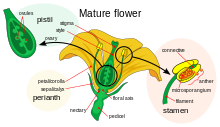User:Chrisnoriega8/sandbox

Gender
Sex can be determined by sex itself or gender. Sex is described as being determined by genetics or context while gender is determined by contributed gametes/percentage and social roles. In this article, it will be explaining how to determine gender in plants. Many of us probably didn't even know that there were male and female species of plants but there are. There are various plant species and each one has a gender whether it is male, female or both. Now, this must spark a wondering feeling of why plants can be both male and female. There are some plant species that are known to be hermaphrodites, which means they have both male and female reproductive organs on one flower or maybe different branches of the same plant. To identify these organs one must be very careful and delicate with the flower or plant due to how fragile it is. Some examples of this are Roses, Lilies, and Sunflowers and these plants have both male and female parts. The male parts of a flower are known as the stamens and anthers. The anthers contain the flower’s pollen. The female organs of a flower are known as the pistil. This pistil has three parts – the stigma, style and ovary. Pollinators carry pollen from the male anther to the pistil, where it then fertilizes and grows into seeds. These organs on flowers/plants are very delicate and at times can be very difficult to see but, these parts allow plants to reproduce and keep growing as a species. Many flowers and plants are very different and each have different areas or spots where these particular areas can be seen whether these different reproductive organs are male or female organs. Gender is not only an ideal for humans or animals, but most living things including plants.
 | This is a user sandbox of Chrisnoriega8. You can use it for testing or practicing edits. This is not the sandbox where you should draft your assigned article for a dashboard.wikiedu.org course. To find the right sandbox for your assignment, visit your Dashboard course page and follow the Sandbox Draft link for your assigned article in the My Articles section. |

test evaluation of kangaroo page[edit]
- ^ "Gender", Wikipedia, 2019-10-15, retrieved 2019-11-04
- ^ "Plant reproductive morphology", Wikipedia, 2019-09-23, retrieved 2019-11-05
- ^ "Sex determination in Silene", Wikipedia, 2019-10-05, retrieved 2019-11-05
- ^ "Hermaphroditic Plant Info: Why Are Some Plants Hermaphrodites". Gardening Know How. Retrieved 2019-11-05.
- ^ Narsaria, Anupriya (2019-09-06). "Plant Reproduction: How Do Plants Reproduce?". Science ABC. Retrieved 2019-11-05.
- ^ "Sex-determination system", Wikipedia, 2019-11-04, retrieved 2019-12-05
- ^ "Sexual differentiation in humans", Wikipedia, 2019-10-11, retrieved 2019-12-05
- ^ Klinkhamer, Peter G. L.; de Jong, Tom J. (1993-05). "Phenotypic Gender in Plants: Effects of Plant Size and Environment on Allocation to Seeds and Flowers in Cynoglossum officinale". Oikos. 67 (1): 81. doi:10.2307/3545098. ISSN 0030-1299.
{{cite journal}}: Check date values in:|date=(help)
